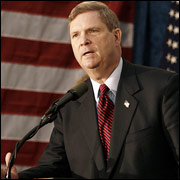
To call ex-Iowa governor Tom Vilsack a dark horse candidate for the Democratic presidential nomination is to underestimate the chances of dark-colored horses. But it seems to have freed him up to make some serious policy proposals.
The energy plan (PDF) Vilsack unveiled on Tuesday is the ballsiest and most detailed any candidate from either party has offered. The headline component is that the plan would reduce greenhouse gas emissions by 75% by 2050.
For the rest, I’ll steal this summary from the San Diego Union-Tribune:
* Seek a 75 percent reduction in greenhouse gases produced by the United States by 2050, principally through a mandatory "cap and trade" program among businesses and other institutions. …
* Require all automotive fuel producers to reduce the amount of carbon dioxide generated by that fuel by 1 percent a year for 10 years.
* Provide a 25-cent-per-gallon federal tax credit for the production of ethanol, an alternative fuel, from so-called cellular fiber. Production of ethanol from corn is expected to fall far short of meeting such an increase, so Vilsack, like Bush, would seek an acceleration of research into production of "cellulosic" ethanol made from wood chips, switchgrass and other feedstocks.
* Spur the nation toward a goal of 60 billion gallons of "renewable" automotive fuels used annually, 45 billion of them cellulosic ethanol or a similar fuel source, biobutanol. Vilsack would require an unspecified reduction in the consumption of petroleum products by cars, and seek vehicles that are 50 percent more fuel-efficient, both by 2030. At that point, he said, the energy for the nation’s entire transportation system would be domestically produced.
* Strive to make the nation’s whole transportation system "virtually petroleum-free."
* Mandate that by 2010, new coal-fired power plants meet "tough new standards for emissions" under an amended Clean Air Act.
* Require all new power plants be "carbon-free" by 2020 — a goal some environmental analysts doubted is possible so soon. Wind, solar, geothermal and nuclear power would qualify, as would coal-fired power facilities that capture 100 percent of carbon dioxide.
That last bullet point is probably the most significant, but also the most difficult. Enforcing that would require some major costs in the short-term. But if Vilsack were elected with this plan on the table, it would be a considerable mandate for action on the energy issue.
Here he is talking with George Stephanopoulos about it, frantically dodging the question of an energy tax:

